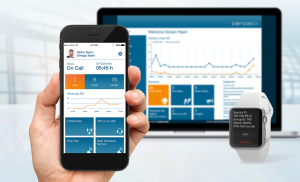The area of alerting has very much matured over the past 10 years and there is now a number of specialized vendors in both mass notifications and operational alerting. It can be very difficult to make the right choice for a specific business need. However, it is possible to identify these two main segments and to categorize alerting solutions accordingly for a better decision on fitness for purpose. Nonetheless, one will often find overlapping between segments and there is often need for multiple applications of an alerting solution within a single organization.
Emergency Mass Notifications
A very prominent segment is called ‘emergency mass notifications‘ services or systems – EMNS. There is even a Gartner Magic Quadrant for it. Those services are provided by quite a number of vendors, usually offered as a shared and public cloud service. Common applications cover storm and flood warnings or large-scale incidents like a fire with subsequent building evacuation. Typically, those EMNS are used once or twice a year, whenever such critical events happen. A mass alert broadcast is triggered manually, usually through a web mask with a predefined list of destinations. There are specific requirements, in particular on ad-hoc scalability. Mobile apps don’t go well with such alerting because of the rare use. There is little need for duty and schedule management and users and contact information are often managed by uploading a CSV or Excel file (with all up-to-date issues arising from it). The pricing model should be event-centric, i.e. ideally one pays per notification broadcast.
Operational Alerting
The second segment contains operational alerting solutions. Operational alerting solutions should be embedded deeply into mission-critical infrastructure, let it be IT, manufacturing control systems or any other operational equipment, because they process data and events from such infrastructure, e.g. a Microsoft System Center ITSM stack. Unlike EMNS, operational alerting systems are in continuous use because they are meant to alert operational staff upon incidents of lesser severity (which of course potentially grow into larger incidents if not handled properly). Instead of alerting a large number of people once or twice a year, these systems alert very few people a couple of times a day or a night or even more frequently during a workers shift. Instead of mass distribution of the same information, the key here are targeted, incident-specific alert messages to responsible and skilled personnel. On top, there are very specific needs that have to be addressed like alarm flood handling or de-duplication. Mobile apps are ideal and should be combined with other comm channels. Ideally, the alerting & acknowledgement process is automated because it reduces errors and speeds up alerting and response. Operational alerting solutions need to seamlessly and securely integrate with infrastructure and are thus often deployed side-by-side with the very mission-critical systems they are connected to. Though there are cloud solutions, many organizations still favor on-premise alerting systems for integration and security reasons.
Derdack’s Enterprise Alert is a premier example of an operational alerting system. Its strengths lie in the automation capabilities, the deep infrastructure integration and its closed-loop incident management approach, i.e. the combination of alerting, incident-centric collaboration and anywhere remedial. Nonetheless, the Derdack solution is equipped with a feature for enterprise-wide mass notifications (called ’emergency call-outs’). Though this feature is very powerful it is just an extension of the core functionality for powerful operational alerting.
What’s right for me?
In my point of view it goes down to a simple fact: depending on the size of your organization and the number of business units, you will likely need several solutions, one for emergency notifications and one or more for operational applications (e.g one for the IT, one for the manufacturing, etc). Sometimes, operational alerting can be consolidated (Enterprise Alert can do this) but not all organizations go down this path (though there a cost savings). In some cases, emergency notifications can be covered by your operational alerting system, too.
Be aware that some EMNS vendors claim to cover both theaters with a single technology stack. But with growing maturity and scenario specialization and the different solution design it is unlikely this is going to work out to your satisfaction. An ENMS can certainly also be used for some very basic operational scenarios but it lacks essential features as it is built for broadcasting not targeting. And an operational alerting system without specific features for mass notifications (like the Enterprise Alert ’emergency call-out’ add-on) cannot be used for emergency scenarios.
Both scenarios are very different and you need to consider the core of your scenario when choosing your solution.
You are welcome to take a look at Enterprise Alert.

